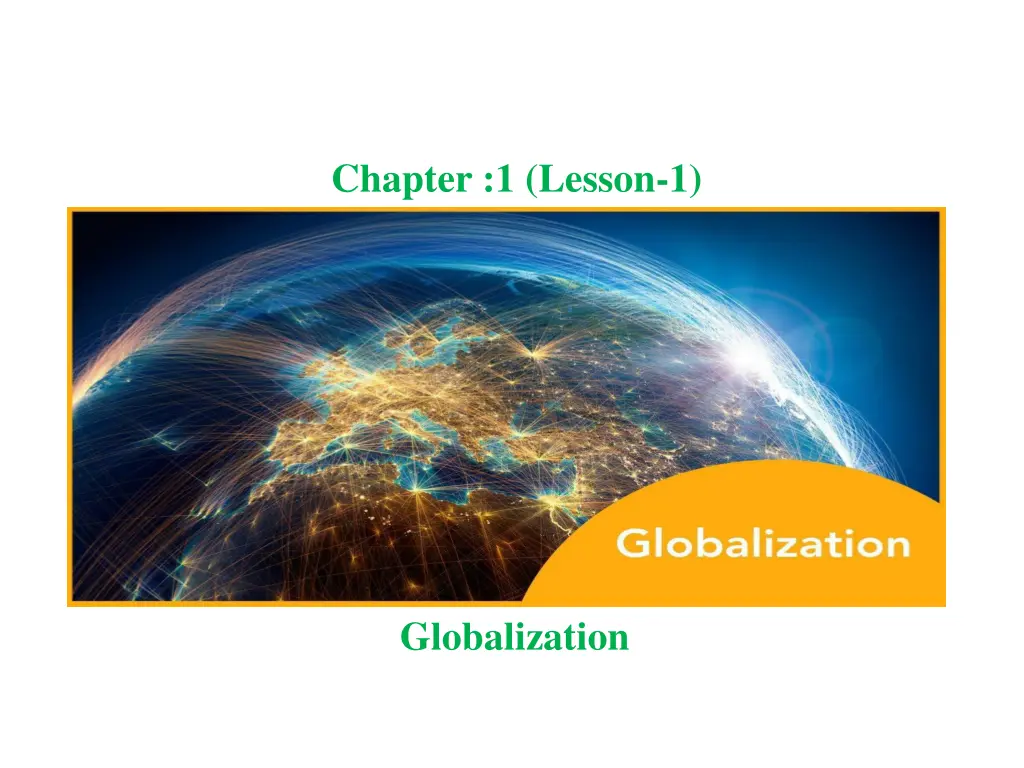
Understanding Globalization: Main Concepts and Factors
Explore the concept of globalization, its components, and factors contributing to increased globalization. Learn about international business, why firms go global, and the barriers and drivers affecting global trade. Enhance your understanding of how globalization shapes the interconnected world economy.
Download Presentation

Please find below an Image/Link to download the presentation.
The content on the website is provided AS IS for your information and personal use only. It may not be sold, licensed, or shared on other websites without obtaining consent from the author. If you encounter any issues during the download, it is possible that the publisher has removed the file from their server.
You are allowed to download the files provided on this website for personal or commercial use, subject to the condition that they are used lawfully. All files are the property of their respective owners.
The content on the website is provided AS IS for your information and personal use only. It may not be sold, licensed, or shared on other websites without obtaining consent from the author.
E N D
Presentation Transcript
Chapter :1 (Lesson-1) Globalization
Learning objectives After reading this chapter, students will be able to- 1. Understand what is meant by the term globalization. 2. Recognize the main drivers of globalization.
Lesson Contents 1. What is globalization? 2. Factors in increased globalization 3. What is international business? 4. Why firms go international? 5. Basic concepts of international business 6. Reasons for international business 7. Barriers to international trade
What is Globalization? The broadening set of interdependent relationships among people from different parts of a world that happens to be divided into nations. It refers to the integration of world economies through the reduction of barriers to the movement of trade, capital, technology and people.
What is Globalization? Globalization has two main components: Historically distinct and separate national markets are merging and creating the globalmarket Falling trade barriers make it easier to sell globally Consumers tastes and preferences are converging on some global norm Firms promote the trend by offering the same basic products worldwide
What is Globalization? Globalization has two main components: Firms source goods and services from locations around the globe to capitalize on national differences in the cost and quality of factors of production like land, labor, energy, and capital Companies can olower their overall cost structure oimprove the quality or functionality of their product offering
Factors in increased Globalization 1. Increase and expansion of technology 2. Liberalization of cross border trade and resource movement 3. Development of services that support international business 4. Growing consumer pressures 5. Increased global competition 6. Changing political situations 7. Expanded cross national cooperation
What is International Business? All commercial transactions including sales, investments, and transportation that take place between two or more countries. John D Daniels and Lee H Radebaugh in their book, InternationalBusiness , define international business as, all commercial transactions- private and governmental between two or more countries. Private companies undertake such transactions governments may or may not do the same in their transactions. These transactions include sales, investments and transportation . for profit;
Why Firms Go International? Several factors underlie the growth of international business. These could be put as: Facilitators, Drivers, Attractions and Compulsions. Facilitators, Drivers, Attractions and Compulsions of International Business Facilitators Drivers Attractions Compulsions 1. Factor mobility 2. Economic reforms 3. Opening up of command economics 4. The Bretton Woods system / WTO regime 5. Developments in communication and transportation technology spheres. 1. Innate growth impetus or urge of the MNCS 2. Constant search for growth 3. Management culture of MNCs 1. Access to the raw materials 2. Sales growth 3. Low cost production 4. Enhanced profitability 1. limitations of domestic market 2. Risk-minimizing by diversification
Basic Concepts of International Business Basic Concept of International Business
Basic Concepts of International Business Exporting and Importing: Exporting is concerned with the selling of domestic goods in another country. Importing is concerned with purchasing goods made in another country. Balance of Trade: The Balance of trade represents the difference between the visible export and import. It may be shown in the following way. Balance of Trade = Visible export-Visible import. Favorable balance of trade: Favorable balance of trade indicates that a country s export is higher that its import. Unfavorable balance of trade: When a country s imports are higher than its exports, then it is called unfavorable balance of trade.
Basic Concepts of International Business Balance of Payment: A Balance of payment represents the difference between visible plus invisible export and visible plus invisible import. It may be shown in the following equation. Balance of payment = (Visible export + invisible export)- (Visible import +invisible import) Favorable balance of payment: If more money is flowing in the country than flowing out of the country. Unfavorable balance of payment: An unfavorable balance of payment exists when more money is flowing out of the country than flowing in.
Basic Concepts of International Business Exchange Rate: It is the rate at which one country can exchange its currency with other country s currency. Exchange rate is of four types: Devaluation: Reducing the value of nation s currency in relation to currencies of other nations. Revaluation: Revaluation increased the value of a country s currency in relation to that of the other countries. Fixed exchange rate: It is an unvarying exchange rate, which is set by the government. Floating exchange rate: An exchange rate that fluctuates with market conditions.
Reasons for International Business No nation in the world can produce all of the products that its people need and want. Some nations have an abundance of natural resources and lack of technological know-how, like Saudi Arabia and some there countries have sufficient technology but few natural resources, like Japan. If a country becomes self-sufficient then other nations would like to trade with that country in order to meet their people s want. Two (2) main reasons for international business are: 1. Absolute advantage 2. Comparative advantage
Barriers to International Trade 1. Cultural and social barriers 2. Political barriers 3. Tariffs and trade restrictions Tariffs Quotas Embargoes 4. Boycotts 5. Standards 6. Anti dumping Penalties 7. Monetary Barriers Blocked currency Differential exchange rate Government approval for securing foreign exchange
Thank you for you nice cooperation Any Question?????






















